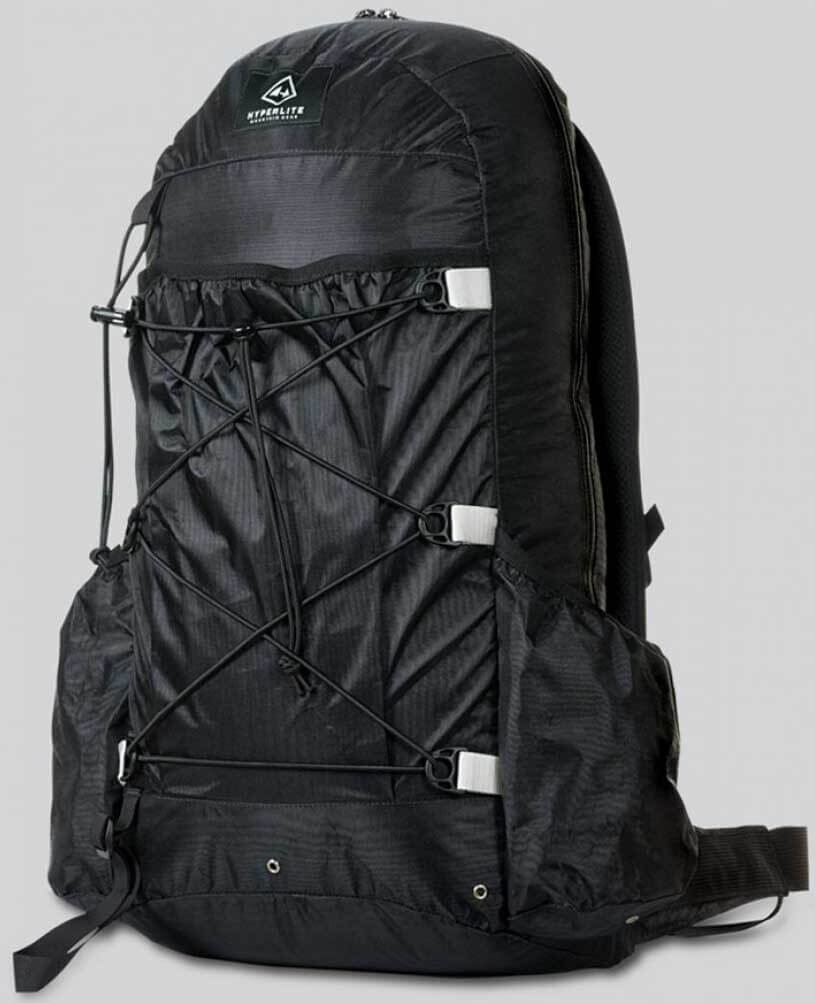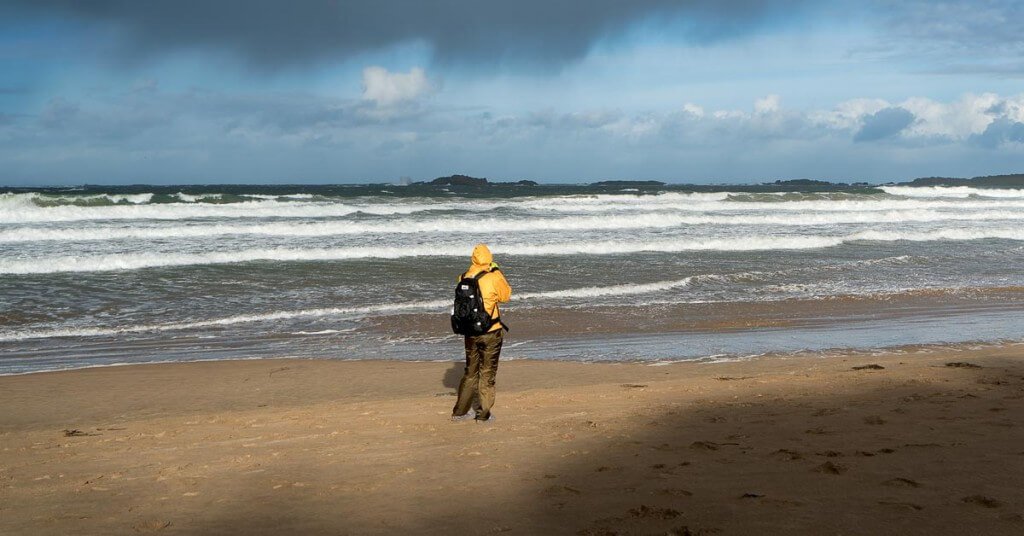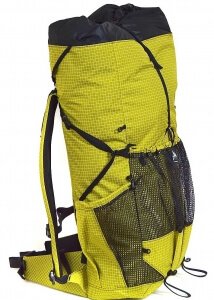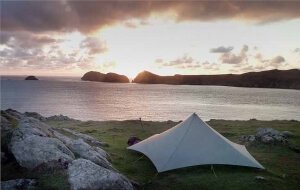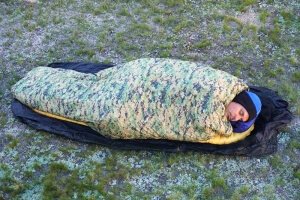A backpack is the single most important piece of gear that any backpacker will own. As such, there is no reason to settle for a heavy, old-school pack. That’s why this buyer’s guide highlights the very best backpacking backpacks for hiking.
This guide will help you find the best ultralight daypack averaging less than 1 lb. Full size, fully-featured day hiking backpacks can be very lightweight.
Our recommended multi-day fastpacking backpacks are ultralight, low volume, and offers an extra secure torso fit to prevent gear from bouncing. This buyer’s guide covers all of our top picks.
A top tier hiking fanny pack is very useful and extremely versatile. Keep your valuables safe and essentials on-hand!
The $16 HIKPRO 20L Backpack is a great value for a light daypack. Best, it delivers in-field performance at a fraction of the cost & weight of most daypacks from well-known brands.
While the Southwest 2400 is our favorite backpacking pack, the Hyperlite Mountain Gear Daybreak Daypack is our favorite pack for every other need. It is the waterproof ultralight daypack that we trust with $5K to $10K of camera gear in rain soaked places like Iceland or the Northern Coast of Ireland. It is our under-seat carry on pack on the plane. Then when off the plane, we can live out of this same pack for a week of hiking in foreign countries. It is an alpine climbing, done-in-a-day pack. We also use it technical canyoneering, skiing for groceries in a winter blizzard, etc. In summary, it may be the best multipurpose ultralight daypack on the market. Oh, and it also won National Geographic Adventure Mag 2016 “Gear Of The Year.”
Quick Specs – Hyperlite Mountain Gear Daybreak Daypack
- Volume: Internal: 1040 cu. in. (17L)
- Load capacity: Up to 25 lbs
- Weight: Size Medium 1.27 lbs | 20.35 oz | 577g
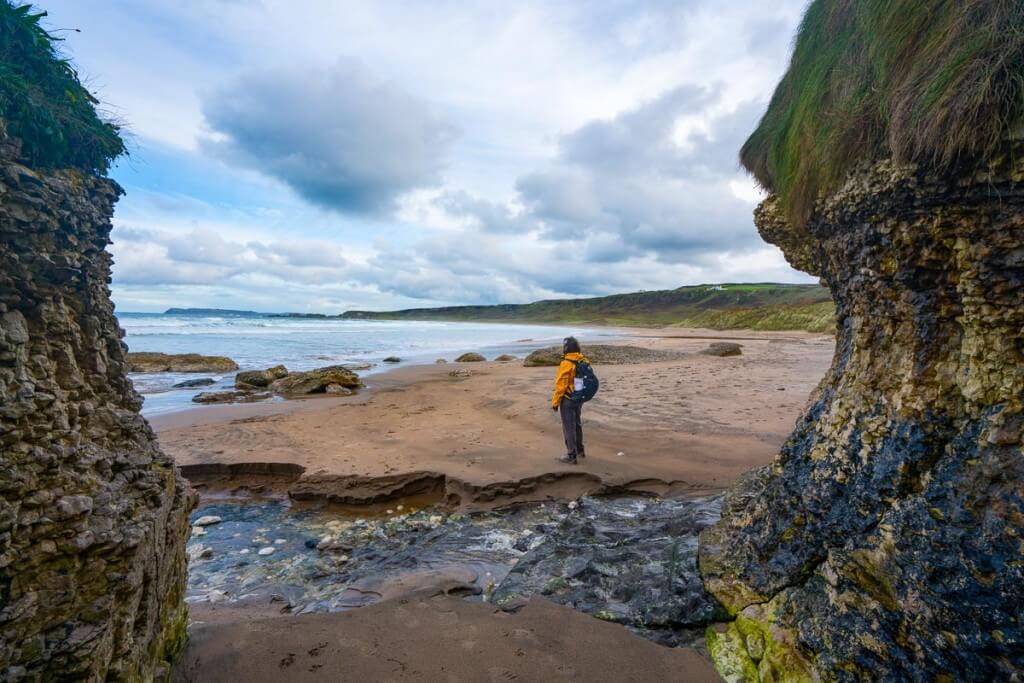
Alison on the very wet coast of N. Ireland. Her Hyperlite Mountain Gear Daybreak Pack has thousands of dollars of camera gear in it. This despite on and off torrential wind and rain for days on end.
5 Key Features of the Hyperlite Mountain Gear Daybreak Daypack
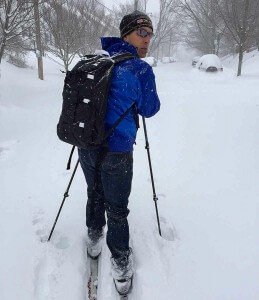
Skiing out to get food during the the Blizzard of 2016.
- It’s nearly waterproof. Important when you’re carrying expensive cameras, electronics or clothing you’re depending on to stay warm, like a down jacket.
- It’s tough. The black Dyneema Composite Fabric (DCF), is strong and waterproof, but still light. Pockets are durable, solid fabric.
- It’s light. At just over a pound for a 17 liter capacity, it is significantly lighter than most waterproof packs.
- Fast gear Access. The clamshell, waterproof top zipper gives faster access to the main pack-bag vs. packs with lids, or roll-top closures. The Daybreak has the perfect combination of external storage: a large bellows back pocket; two side pockets for water bottles, etc.; a nice rear bungie system that you can attach a helmet, crampons or rainwear, etc.; and additional attachment points on both the back of the pack and on the shoulder straps. In summary, you can carry a lot of gear, organize it well and access it quickly.
- “Precisely what you need and nothing more.” And finally as with all HMG products the 20 ounce Daybreak Ultralight Daypack epitomizes HMG’s minimal but supremely functional design. As such, they’ve included small details like drain holes for the external pockets, a zippered security pocket for passport, wallet, cash and keys, etc.; and an internal sleeve pocket (I use for maps/papers on-trail and for my 13″ laptop when off-trail/traveling). Oh, and the waist belt is beefy enough to actually handle a decent load!
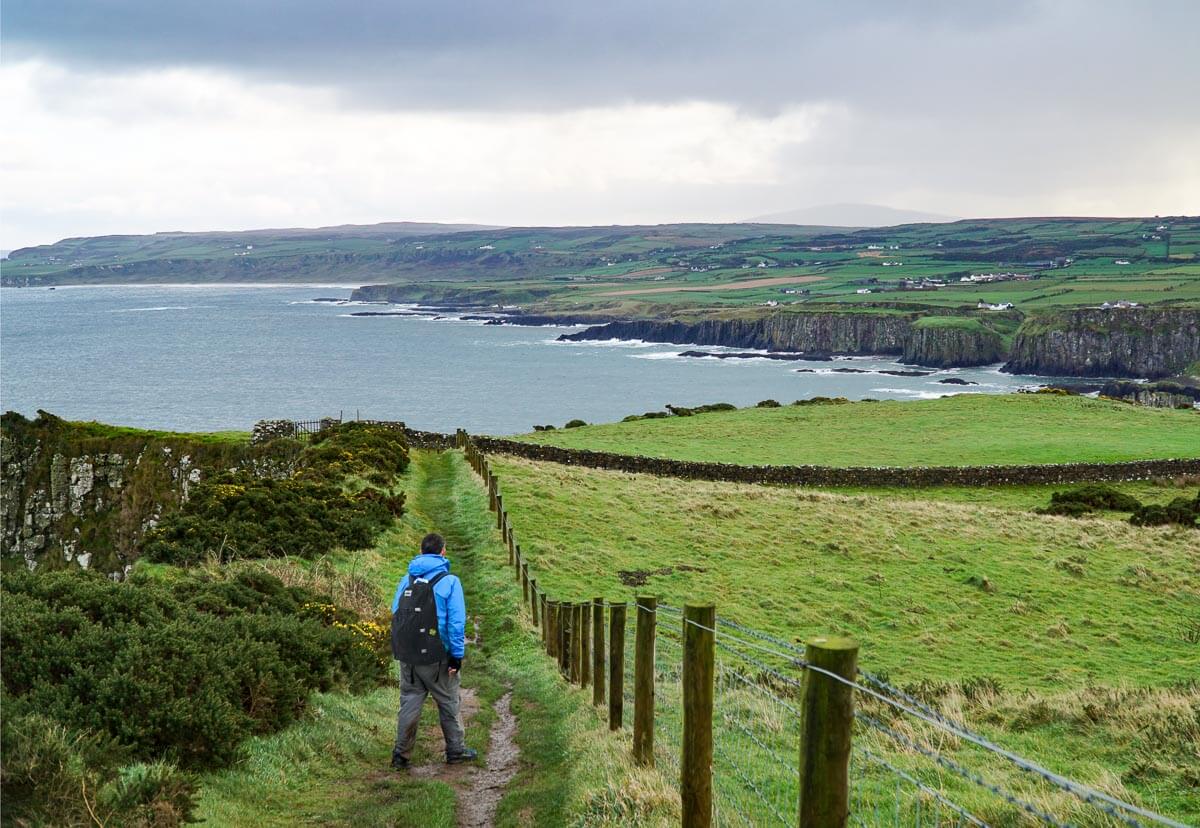
Walking the Causeway Coast Way in County Antrim, Northern Ireland. We rarely took our rain jackets off! photo: Alison Simon
5 Reasons We Like the Hyperlite Mountain Gear Daybreak Daypack
There are a number of cheaper functional daypacks. We’ve outlined some of our favorite daypacks in 3 lb Ultralight Day Hiking Checklist. So why is the $225 HMG Daybreak Ultralight Daypack our favorite?
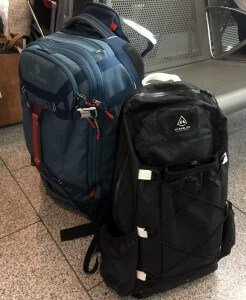
When flying we use or Daybreak packs as our under-seat carry-ons. Then when off the plane, we can live out of this same pack for a week of overnight hiking in foreign countries.
- First we carry a lot of expensive camera gear and electronics on every trip. A few hundred dollars to keep it dry and safe vs. the thousands of dollars of camera gear seems like a good investment. [In, fact we often use it as a dedicated camera bag/pack on some trips. It’s much lighter and more waterproof than many camera-specific packs that weigh 3 pounds or more.]
- Second, we use our Daybreak Daypacks over and over again. As such the cost is very reasonable if you spread it out over many trips per year over a number of years. E.g. the pack goes on international trips (both carry on luggage and on-trail pack), X-country ski trips, surviving temporary immersion when canyoneering, mountaineering, and trips all around the world.
- We know that our packs will survive whatever the terrain or weather dishes out. The fabric is strong and durable and up to bushwhacking and abrasion on rocks. It doesn’t have annoying mesh pockets that snag and tear on everything in creation. And we know that the inside of our pack will remain relatively dry. This is especially important to us since we seem drawn to hiking wet and cold places like Patagonia, Scotland, Iceland, and South Island of New Zealand, etc.
- It’s excellent external storage keeps our most needed gear easily accessible. This is much faster and convenient vs. diving into the main bag for commonly needed items. The huge, rear pocket and shock cord attachment system are keys for this.
- Finally, the packs are amazingly light given how waterproof and durable they are. Greatly appreciated as much when traveling as when we are on the trail.
SPECIFICATIONS – DAYBREAK ULTRALIGHT DAYPACK
Weight
Small 1.26 lbs | 20.14 oz | 571g
Medium 1.27 lbs | 20.35 oz | 577g
Large 1.29 lbs | 20.56 oz | 583g
FEATURES
- Large external front pocket, great for hydration/snacks/rain jacket
- Removable ice axe attachments
- Front shock cord system allows you to lash gear or compress the pack
- Two angled side water bottle pockets that are easy to reach while wearing the pack
- Clamshell design and long water-resistant YKK zipper allows for wide pack access
- Lightly padded 1.5” hip belt with peekaboo pocket to store hip belt when it’s not in use
- Internal zippered pocket designed to hold phones/keys/money/etc
- Internal sleeve pocket helps to compartmentalize your gear (also fits a 13” laptop)
- Bright orange liner makes it easy to see what’s in your pack
- Comfortable ¼” padded back panel with chevron-stitched design
- Dyneema® Hardline shoulder straps with ¼” foam, spacer mesh and elastic hose keepers
- Adjustable sternum strap with whistle
Materials:
External: 150D Dyneema®/Poly Hybrid
Internal: 150D Dyneema®/Poly Hybrid | 210D Nylon
Volume: Internal: 1040 cu. in. (17L)
Dimensions:
Height: 21” (53.3cm) Bottom Width: 11” (27.9cm) Depth: 6.5″ (16.5cm)
Disclaimers
- This post contains affilate links. If you make a purchase after clicking on the these links, a slight portion of the sale helps support this site at no additional cost to you. I am never under an obligation to write page post a review about any product. Finally, this post expresses my own independent opinion.
- Hyperlite Mountain Gear provided the author a sample of this pack for review.
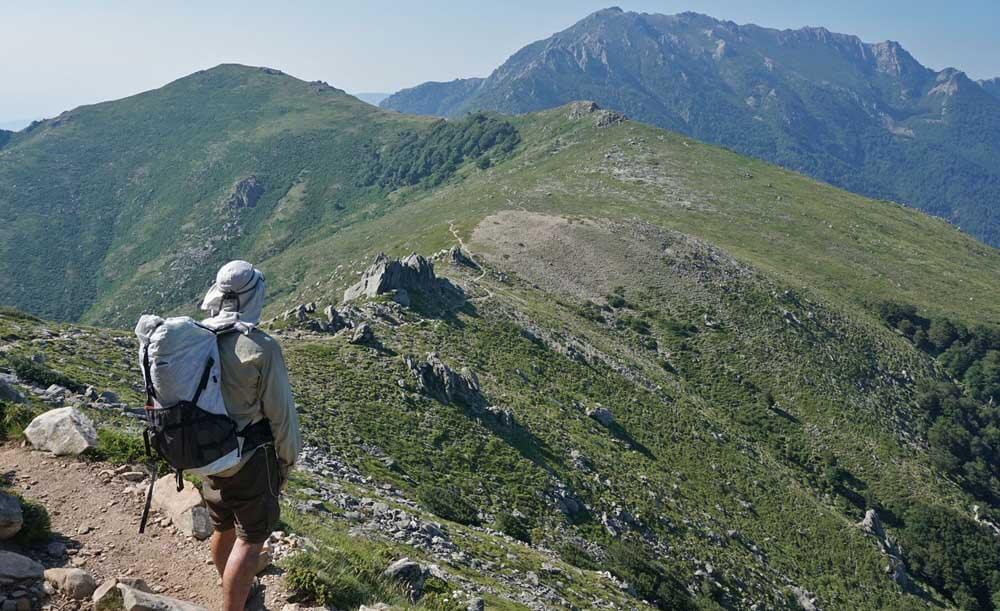
Moving fast and light along the spectacular ridge line of the GR20 in Corsica. A minimal pack (and good pre-trip training) enabled Alison and I to do a 16 day trip in under 8 days. Pictured – the award winning Hyperlite Mountain Gear 2400 Southwest Pack
You make Adventure Alan & Co possible. When purchasing through links on our site, we may earn an affiliate commission at no additional cost to you. Here’s why you can trust us.
Quick ways to reduce backpack weight. A few may surprise you…
- Look at The Big Three: Backpack, Tent/shelter, and Sleep System (sleeping bag, sleeping pad, and ground cloth). You stand to lose a bunch of weight from these: as much as 10 to 12 pounds.
- Take a Backpack that weighs less than two pounds. See our: Best Backpacks for Backpacking and Hiking
- Take a Tent that weighs less than two pounds. See our: Best Backpacking Tents | Lightweight & Ultralight
- Take a Sleeping bag that that weighs less than 1.5 pounds. See our: Buyers Guide to Lightweight Backpacking Quilts & Sleeping Bags
- Look at our 9 Pound Full Comfort Lightweight Backpacking Gear List for more ideas for gear to save weight.
Nine pounds of backpacking gear is all a hiker needs to be safe and warm. Or simply put, this list has better backpacking gear. For over a decade it’s been tested, refined, and updated to reflect only the best and most current backpacking gear now available in 2019. So, if you want to reduce pack weight without reducing comfort, look no further! The hiking gear in this guide is suitable for all 3-season conditions on trips around the world, from Alaska, to Patagonia, to Utah.
- Look on The Backpacking Food Page to save a ton of weight at zero cost
- Get a weather report (the NOAA hourly weather graph is among the most informative and accurate)—then pack for those conditions! Since 90% of backpackers take 90% their trips for 3 days or or less, this weather report should be quite accurate for the short time you are out. This will let you pack a tent, clothing, and sleeping bag appropriate for actual conditions. It will also deter you from taking inappropriate, “what-if-the-worst-happens!” gear, e.g. 6 pound tent, and a +10F sleeping bag for a balmy weather trip on the Appalachian Trail.
- Don’t take extra clothing. e.g. don’t take any more clothing than you can wear at one time.
- Take less: Be disciplined and leave a few items at home that you haven’t used in the last three trips. Put stuff like sunscreen and trail soap in smaller containers.
- Extra Credit: Browse The Gear Lists Page for other ideas and examples to save weight. This will give you a good examples of what type of gear is available and what is a reasonable weight for that type of gear, e.g. around 6-8 ounces for a rain jacket, or around 1.0 ounce for a pocket knife. Think hard if your gear is 2 to 3x heavier than the examples on these lists.
- Read my The Best Hydration — Drink When Thirsty. Use a Sawyer Squeeze Water Filter to drink at the source (lake, stream, etc.). Then only carry a sensible amount to get to your next known water source. I.e. it makes no sense to carry 3 liters of water, almost 7 pounds, when your next water source is only two hours away.
- Remember to have fun! That will at least, lighten your spirit and mood.
How Do I Start?
- Ground yourself in reality: Get all your stuff together and weigh it. If you’re like most conventional hikers, your equipment will weigh around 30 pounds, possibly higher.
- Get individual weights for your heavier items like tents and backpacks. For stuff in the range of a few pounds or less you’ll want to buy an inexpensive digital scale that weighs up to 10 pounds.
- See what you can leave at home. Anything you don’t bring is free weight reduction. Think hard about this one. Do you really need it?
- Put together a spreadsheet (or at least a list) with all your equipment weights. This is an indispensable analysis tool.
- Try to figure out where you’ll get the most “bang for the buck.” e.g. figure out how much a new item costs and divide that by the amount of weight it will save you over your old equipment. Target the items that give you the most weight loss for the fewest dollars.
- Buy on Sale: Don’t try to purchase all your new equipment right away. Many items regularly go on sale or are closed out. Watch carefully over the course of a year and you could save 30 to 70 percent on your equipment.
These Recommended Lightweight Backpacks are your first choice if you want one light pack to work for all your trips. These packs will carry gear and food for trips up to 7 days or more—yet at around 2 pounds they are not too heavy to use for a long weekend on the Appalachian Trail. They have an internal frame to support heavier loads and will accommodate a bunch of gear and/or a bear canister.
lead photo: The Hyperlite Mountain Gear 2400 Southwest Pack on the rugged terrain of the GR20 in Corsica. This pack is a favorite and a Backpacker Magazine award winner for “Best UltraLight Pack.”
Do-it-all Packs for most trips up to a week (or longer)
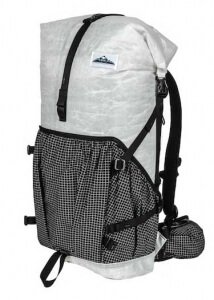
Hyperlite Mountain Gear Packs: HMG makes very light, functional and extremely durable packs. The 3400 Southwest Pack will work for most trips, even those requiring a bear canister. The 2400 Southwest Pack is a personal favorite and a Backpacker Magazine award winner for “Best UltraLight Pack.” For longer trips it’s great for those with a more compact kit. Its slim profile gives great balance for scrambling. HMG packs have stiff frames, capable of supporting heavy loads. HMG packs are Cuben Fiber which is light, waterproof and extremely durable. Seam taping and a roll-top closure make these packs virtually waterproof! left: HMG Southwest 2400. Light, rugged & versatile. Can be dragged across rock. Nearly waterproof. |
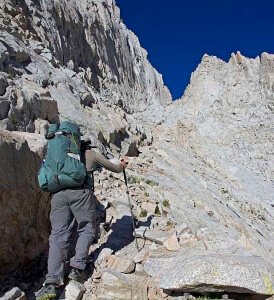
ULA Equipment Packs: ULA packs are a great value. They have much of the performance of HMG packs but cost less. The Circuit Pack will work for most trips, even those requiring a bear canister. The Ohm 2.0 Pack is great for those with a more compact kit and/or shorter trips (although I carried gear and food for 7 days on the Southern Sierra High Route including a bear canister). Its slim profile gives great balance for scrambling. ULA packs are Robic fabric which is light and reasonably durable but inexpensive, keeping pack prices down. right: The Ohm 2.0 Pack: Slogging up the Mountaineer’s Route on Mt. Whitney carrying a bear canister and 7 days worth of food in a ULA Ohm 2.0 pack. Its slim profile gives great balance for scrambling and its durable construction is up to the abuse of climbing Sierra granite. In this case it allowed us to climb over the summit of Whitney mid-trip on the Southern Sierra High Route. |
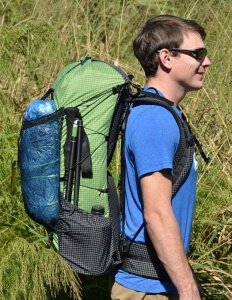
Z-packs Arc Packs: If you hike mostly on trails, this might be the pack for you. What sets it apart is the load carrying capacity of its external frame. Z-packs does a modern, lightweight carbon fiber reinvention of the external frame backpacks of the 70’s and 80’s. Make no mistake, nothing transfers load to your hips like an external frame pack. Their Flexed Arc carbon fiber frame creates an air gap against your back, reducing that sweaty back feeling. The external frame has some considerations for off trail use. It doesn’t move with your torso as much as an internal frame pack when scrambling on rough terrain. And if you need to haul or lower your pack the external frame is exposed. It could catch on things and/or be damaged [but guessing that the majority of readers don’t haul their packs on rock]. The are Arc Haul uses more economical Dyneema fabric. The Arc Blast uses, lighter but expensive Cuben Fiber. left: Z-packs Arc Pack: What sets it apart is the load carrying capacity of its external carbon fiber frame. |
 Osprey Exos 58 Pack: The main advantage of the Exos 58 is off the shelf availability form major retailers like REI (the rest of the packs on this page are not). At 2.7 pounds the Exos 58 is almost a pound heavier than other packs on this page but has features like a breathable, tensioned-mesh back panel frame and a top lid with a pocket that some trail hikers may appreciate. |
| Gossamer Gear Mariposa 60 Pack: A great trail pack with a lot of volume! While not quite as durable for scrambling/bushwhacking as the HMG and ULA packs, the Mariposa is under two pounds and has a bunch of features and creature comforts, like a top lid with a pocket that many trail hikers will appreciate. |
Recommended Lightweight Backpacks for shorter trips (e.g. a long-weekend)
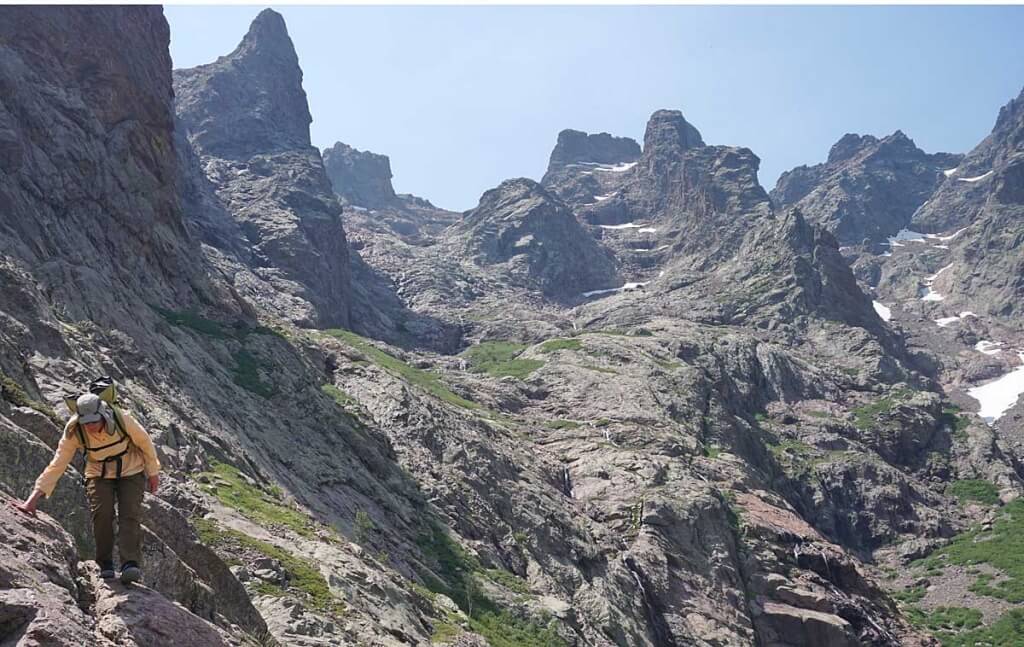
A light and compact pack is a huge advantage when navigating over difficult terrain. Alison descending after the crux of the GR20 with her 1 pound MLD Exodus Backpack
These packs are a great choice for a “long-weekend trip*,” typically 3 days and 2 nights. Their main advantage is that they weigh 10-18 oz, or 1/3 to 1/2 the weight of the Do-it-all Packs. In general, these packs are suited to carrying loads of 10 to 18 pounds. As such, many do not have a frame and/or may have less capacity than the Do-it-all Packs. But some backpackers with a trim gear kit may be able to use these packs for longer tips. *Note: 90% of backpackers take 90% their trips for 3 days or or less.
|
Mountain Laurel Designs Packs: The MLD Exodus Pack is a darling of the AT and a Backpacker Magazine award winner for “Best UltraLight Pack.” At just over a pound, it has the same volume of the Do-it-all Packs but saves weight by not having a frame. With light but durable Dyneema X fabric, it’s surprisingly strong, light and resistant to abuse. The 0.8 pound Burn Pack at 38 liters is a smaller and lighter version of the Exodus and is suitable for backpackers with a trimmer gear kit and/or lighter load. |
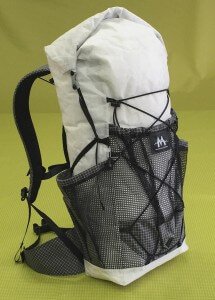 MLD Burn Pack in Cuben Fiber Note: Mountain Laurel Designs is now offering their Burn, Prophet, and Exodus packs in Cuben Fiber. the Cuben Fiber is inherently near-waterproof. When you combine this with a Cuben stuff sacks for your down sleeping bag and jacket, you can pretty much not worry about rain. That means less time dealing with putting on a pack rain cover (they don’t work anyway) or dealing with putting everything in a waterproof pack liner. |
- Hyperlite Mountain Gear 2400 WindRider Pack: The 1.7 pound 2400 WindRider Pack is another winner of Backpacker Magazine’s “Best UltraLight Pack.” This pack is a hybrid between theDo-it-all Packs and Short trip packs. It has a bomber frame to support heavy loads but for many backpackers its 40 liter volume is more appropriate for shorter trips. It’s virtually waterproof and will handle a ton of abuse.
- ULA Equipment CDT Pack: At 1.5 pounds and frameless, the CDT is ULA’s lightest and most basic pack. Like the MLD Exodus, its volume (54 liters) is similar to the Do-it-all packs, only the lack of a frame relegates it to shorter trips for many (but not all) backpackers.
- Zpacks: At around 1.5 pounds the Arc Haul and the Arc Blast from Z-packs, would be a good choice for trail hiking. Especially those with sensitive shoulders that want to transfer the maximum weight to the hip belt.
- Gossamer Gear Packs: Heather ‘Anish’ Anderson used the The Gorilla 40 Ultralight Pack to set the speed record for the Appalachian Trail. At 1.6 pounds, the Gorilla is a hybrid between the Do-it-all Packs and Short trip packs. It has a frame to support heaver loads but its 40 liter volume is more appropriate for shorter trips. The 1.1 pound Kumo Superlight and 0.6 Murmur Hyperlight are frameless 36 liter packs suitable for backpackers with a trimmer gear kit and/or lighter load. Unique to the Gossamer Gear Packs is an external and easily removable foam back-pad. This adds a bit of structure to the frameless packs and can be used as a sit pad for breaks and in camp, and/or to put under your feet at night if you use a shorter sleeping pad.
- Osprey Exos 38 Pack: The main advantage of the Exos 38 is off the shelf availability from major retailers like REI (the rest of the packs on this page are not). At 2.2 pounds the Exos 38 is over twice the weight of most packs on this page but has features like a breathable, tensioned-mesh back panel frame and a top lid with a pocket that some trail hikers may appreciate.

Moving fast and light along the spectacular ridge line of the GR20 in Corsica. A minimal pack (and good pre-trip training) enabled Alison and I to do a 16 day trip in under 8 days.
To save as much as 10 to 12 pounds with with the minimum of effort, look at The Big Three. 1) Backpack, 2) Tent/Shelter, and 3) Sleeping bag (or quilt). The lighter versions of these are just as functional as their heavier counterparts. They will carry your load and keep you warm and dry. The only thing you stand to lose is a bunch of weight off your back.
And most people do not enjoy being a pack mule. It is rarely the highlight or happiest memory of a trip. Alternatively, unburdened from the misery of carrying a heavy pack, folks become joyful and alert—in the best state of mind to appreciate everything around them—the reason they went backpacking. The Big Three is the fastest way to achieve that goal.
The Big Three
1) Take a Backpack that weighs less than two pounds
(see Recommended Backpacks)
2) Take a Tent/Shelter that weighs less than two pounds
(see Recommended Tents, Tarps and other Shelters)
3) Take a Sleeping bag that that weighs less than 1.5 pounds
(see Recommended Sleeping Bags and Quilts)
© Jaeger Shaw, Sustain Succeed LLC, and AdventureAlan.com, 2000-2023 | All Rights Reserved
Unauthorized use and/or duplication of this material without express and written permission from this site’s owner is strictly prohibited. Brief excerpts and links may be used freely without express and written permission, provided that full and clear credit is given to AdventureAlan.com with appropriate and specific direction linking to the original content.
You make Adventure Alan & Co possible. When purchasing through links on our site, we may earn an affiliate commission at no additional cost to you.
Affiliate Disclosure | Privacy Policy | Terms and Conditions | Contact Us

